The Use of Azimuthal Variation in ScS–S Differential Travel Times to Investigate Possible Anisotropy in the Lowermost Mantle Beneath the Philippines
Abstract
1. Introduction
2. Data and Methods
3. Analyses and Results
3.1. Three-Dimensional (3D) Mantle Correction
3.2. Correction for Local Heterogeneity
3.3. Attempt at Anisotropic Parameter Estimation
4. Discussion
4.1. Possible Interpretation of ScS–S Residuals Except for Azimuthal Anisotropy
4.2. Speculation for Azimuthal Anisotropy
5. Conclusions
Funding
Data Availability Statement
Acknowledgments
Conflicts of Interest
Appendix A

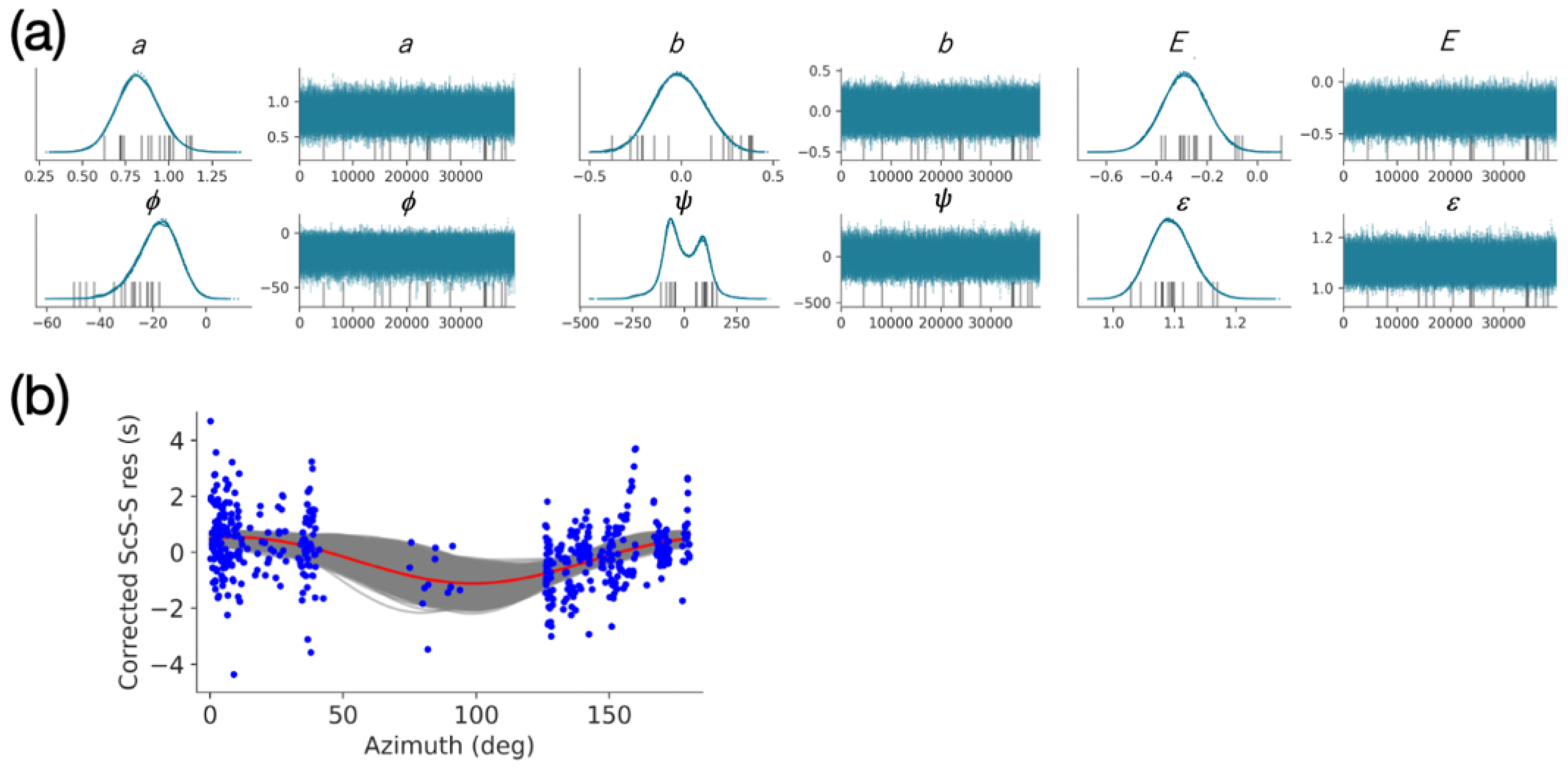
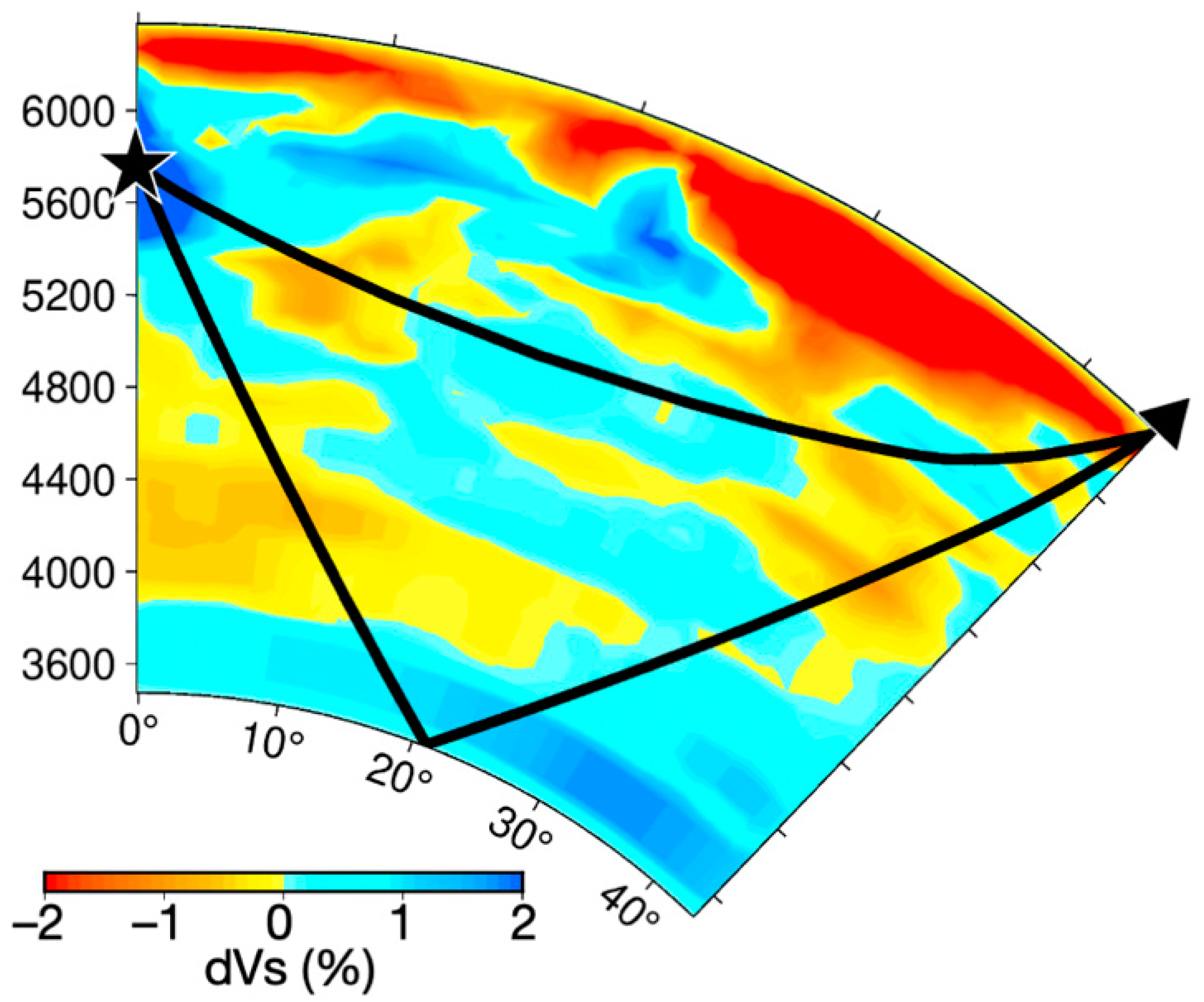

| Model for Correction | Average (s) | Standard Deviation (s) | Correlation Coefficient of ΔTScS–S vs. ΔTS | vs. ΔTScS |
|---|---|---|---|---|
| S16U6L8 | 0.34 | 1.92 | −0.49 | 0.31 |
| SB4L18 | 0.03 | 1.90 | −0.59 | 0.38 |
| S40RTS | 1.01 | 1.54 | −0.42 | 0.43 |
| UCB-SEM-WM | 0.78 | 2.03 | –0.67 | 0.30 |
| TX2019slab | 0.00 | 1.33 | −0.38 | 0.38 |
| Parameters | Inferred Value | Standard Deviation |
|---|---|---|
| a | 0.84 | 0.13 |
| ϕ | −19.84 | 13.08 |
| b | 0.13 | 0.10 |
| ψ | 108.23 | 22.67 |
| E | −0.28 | 0.09 |
| Parameters | Average | Standard Deviation |
|---|---|---|
| a | 0.82 | 0.12 |
| ϕ | −18.16 | 7.69 |
| b | −0.01 | 0.14 |
| ψ | −0.63 | 91.15 |
| E | −0.30 | 0.09 |
| ε | 1.09 | 0.04 |
References
- McNamara, A.K. A review of large low shear velocity provinces and ultra low velocity zones. Tectonophysics 2019, 760, 199–220. [Google Scholar] [CrossRef]
- Dziewonski, A.M. Mapping the lower mantle: Determination of lateral heterogeneity in P velocity up to degree and order 6. J. Geophys. Res. 1984, 89, 5929–5952. [Google Scholar] [CrossRef]
- Tanimoto, T. Long-wavelength S-wave velocity structure throughout the mantle. Geophys. J. Int. 1990, 100, 327–336. [Google Scholar] [CrossRef]
- Fichtner, A.; Kennett, B.L.; Tsai, V.C.; Thurber, C.H.; Rodgers, A.J.; Tape, C.; Rawlinson, N.; Borcherdt, R.D.; Lebedev, S.; Priestley, K.; et al. Seismic Tomography 2024. Bull. Seismol. Soc. Am. 2024, 114, 1185–1213. [Google Scholar] [CrossRef]
- Garnero, E.J.; McNamara, A.K.; Shim, S.H. Continent-sized anomalous zones with low seismic velocity at the base of Earth’s mantle. Nat. Geosci. 2016, 9, 481–489. [Google Scholar] [CrossRef]
- Suetsugu, D.; Isse, T.; Tanaka, S.; Obayashi, M.; Shiobara, H.; Sugioka, H.; Kanazawa, T.; Fukao, Y.; Barruol, G.; Reymond, D. South Pacific mantle plumes imaged by seismic observation on islands and seafloor. Geochem. Geophys. Geosyst. 2009, 10, Q11014. [Google Scholar] [CrossRef]
- Li, J.; Zhang, B.; Sun, D.; Tian, D.; Yao, J. Detailed 3D Structures of the Western Edge of the Pacific Large Low Velocity Province. J. Geophys. Res. Solid Earth 2024, 129, e2023JB028032. [Google Scholar] [CrossRef]
- Yu, S.L.; Garnero, E.J. Ultralow velocity zone locations: A global assessment. Geochem. Geophys. Geosyst. 2018, 19, 396–414. [Google Scholar] [CrossRef]
- Wolf, J.; Long, M.D.; Li, M.; Garnero, E. Global Compilation of Deep Mantle Anisotropy Observations and Possible Correlation With Low Velocity Provinces. Geochem. Geophys. Geosyst. 2023, 24, e2023GC011070. [Google Scholar] [CrossRef]
- Creasy, N.; Miyagi, L.; Long, M.D. A library of elastic tensors for lowermost mantle seismic anisotropy studies and comparison with seismic observations. Geochem. Geophys. Geosyst. 2020, 21, e2019GC008883. [Google Scholar] [CrossRef]
- Romanowicz, B.; Wenk, H.R. Anisotropy in the deep Earth. Phys. Earth Planet. Inter. 2017, 269, 58–90. [Google Scholar] [CrossRef]
- Nowacki, A.; Wookey, J.; Kendall, J.M. New advances in using seismic anisotropy, mineral physics and geodynamics to understand deformation in the lowermost mantle. J. Geodyn. 2011, 52, 205–228. [Google Scholar] [CrossRef]
- Thomas, C.; Wookey, J.; Simpson, M. D″ anisotropy beneath Southeast Asia. Geophys. Res. Lett. 2007, 34, L04301. [Google Scholar] [CrossRef]
- Roy, S.K.; Kumar, M.R.; Srinagesh, D. Upper and lower mantle anisotropy inferred from comprehensive SKS and SKKS splitting measurements from India. Earth Planet. Sci. Lett. 2014, 392, 192–306. [Google Scholar] [CrossRef]
- Wolf, J.; Long, M.D. Slab-driven flow at the base of the mantle beneath the northeastern Pacific Ocean. Earth Planet. Sci. Lett. 2022, 594, 117758. [Google Scholar] [CrossRef]
- Asplet, J.; Wookey, J.; Kendall, M. A potential post-perovskite province in D″ beneath the Eastern Pacific: Evidence from new analysis of discrepant SKS–SKKS shear-wave splitting. Geophys. J. Int. 2020, 221, 2075–2090. [Google Scholar] [CrossRef]
- Wookey, J.; Kendall, J.M.; Rümpker, G. Lowermost mantle anisotropy beneath the north Pacific from differntial S–ScS splitting. Geophys. J. Int. 2005, 161, 829–838. [Google Scholar] [CrossRef]
- Wolf, J.; Long, M.D.; Leng, K.; Nissen-Meyer, T. Constraining deep mantle anisotropy with shear wave splitting measurements: Challenges and new measurement strategies. Geophys. J. Int. 2022, 230, 507–527. [Google Scholar] [CrossRef]
- Wolf, J.; Long, M.D. Lowermost mantle structure beneath the central Pacific ocean: Ultralow velocity zones and seismic anisotropy. Geochem. Geophys. Geosyst. 2023, 24, e2022GC010853. [Google Scholar] [CrossRef]
- Ishise, M.; Kawakatsu, H.; Morishige, M.; Shiomi, K. Radial and azimuthal anisotropy tomography of the NE Japan subduction zone: Impllications for the Pacific slab and mantle wedge dynamics. Geophys. Res. Lett. 2018, 45, 3923–3931. [Google Scholar] [CrossRef]
- Liu, X.; Zhao, D. P-wave anisotropy, mantle wedge flow and olivine fabrics beneath Japan. Geophys. J. Int. 2017, 210, 1410–1431. [Google Scholar] [CrossRef]
- Liu, X.; Zhao, D. Seismic velocity azimuthal anisotropy of the Japan subduction zone: Constraints from P and S wave traveltimes. J. Geophys. Res. Solid Earth 2016, 121, 5086–5115. [Google Scholar] [CrossRef]
- Fan, J.; Zhao, D.; Li, C.; Liu, L.; Dong, D. Remnants of shifting early Cenozoic Pacific lower mantle flow imaged beneath the Philippine Sea Plate. Nat. Geosci. 2024, 17, 347–352. [Google Scholar] [CrossRef]
- Kuo, B.-Y.; Forsyth, D.W.; Wysession, M.E. Lateral heterogeneity and azimuthal anisotropy in the north Atlantic determined from SS–S differential travel times. J. Geophys. Res. 1987, 92, 6421–6436. [Google Scholar] [CrossRef]
- Tang, Y.; Obayashi, M.; Niu, F.; Grand, S.P.; Chen, Y.J.; Kawakatsu, H.; Tanaka, S.; Ning, J.; Ni, J.F. Changbaishan volcanism in northeast China linked to subduction-induced mantle upwelling. Nat. Geosci. 2014, 7, 470–475. [Google Scholar] [CrossRef]
- Ohtaki, T.; Suetsugu, D.; Kanjo, K.; Purwana, I. Evidence for a thick mantle transition zone beneath the Philippine Sea from multiple-ScS waves recorded by JISNET. Geophys. Res. Lett. 2002, 29, 24-1–24-4. [Google Scholar] [CrossRef]
- Okada, Y.; Kasahara, K.; Hori, S.; Obara, K.; Sekiguchi, S.; Fujiwara, H.; Yamamoto, A. Recent progress of seismic observation networks in Japan –Hi-net, F-net, K-NET and KiK-net–. Earth Planets Space 2004, 56, xv–xxviii. [Google Scholar] [CrossRef]
- Engdahl, E.R.; van der Hilst, R.D.; Buland, R.P. Global teleseismic earthquake relocation with improved travel times and procedures for depth determination. Bull. Seism. Soc. Am. 1998, 88, 722–743. [Google Scholar] [CrossRef]
- Stark, M.; Forsyth, D.W. The geoid, small-scale convection, and differential travel time anomalies of shear waves in the central Indian ocean. J. Geophys. Res. 1983, 88, 2273–2288. [Google Scholar] [CrossRef]
- Dziewonski, A.M.; Anderson, D.L. Preliminary reference Earth model. Phys. Earth Planet. Inter. 1981, 25, 297–356. [Google Scholar] [CrossRef]
- Tanaka, S.; Hamaguchi, H. Heterogeneity in the lower mantle beneath Africa, as revealed from S and ScS phases. Tetonophysics 1992, 209, 213–222. [Google Scholar] [CrossRef]
- Cormier, V.F. Slab diffraction of S waves. J. Geophys. Res. 1989, 94, 3006–3024. [Google Scholar] [CrossRef]
- Kennett, B.L.N.; Gudmundsson, O. Ellipticity corrections for seismic phases. Geophys. J. Int. 1996, 127, 40–48. [Google Scholar] [CrossRef]
- Liu, X.F.; Dziewonski, A.M. Global analysis of shear wave velocity anomalies in the lower-most mantle. In The Core-Mantle Boundary Region; Gurnis, M., Wysession, M.E., Knittle, E., Buffett, B.A., Eds.; AGU: Washington, DC, USA, 1998; pp. 21–36. [Google Scholar]
- Masters, G.; Laske, G.; Bolton, H.; Dziewonski, A. The relative behavior of shear velocity, bulk sound speed, and compressional velocity in the mantle: Implications for chemical and thermal structure. In Earth’s Deep Interior: Mineral Physics and Tomography from the Atomic to the Global Scale, Geophysical Monograph Vol. 17; Karato, S., Forte, A.M., Liebermann, R.C., Masters, G., Stixrude, L., Eds.; AGU: Washington, DC, USA, 2000; pp. 63–87. [Google Scholar]
- Ritsema, J.; Deuss, A.; van Heijst, H.J.; Woodhouse, J.H. S40RTS: A degree-40 shear-velocity model for the mantle from new Rayleigh wave dispersion, teleseismic traveltime and normal-mode splitting function measurements. Geophys. J. Int. 2011, 184, 1223–1236. [Google Scholar] [CrossRef]
- French, S.W.; Romanowicz, B. Broad plumes rooted at the base of the Earth’s mantle beneath major hotspots. Nature 2015, 525, 95–99. [Google Scholar] [CrossRef] [PubMed]
- Lu, C.; Grand, S.P.; Lai, H.; Garnero, E.J. TX2019slab: A new P and S tomography model incorporating subducting slabs. J. Geophys. Res. Solid Earth 2019, 124, 11549–11567. [Google Scholar] [CrossRef]
- Obayashi, M.; Yoshimitsu, J.; Nolet, G.; Fukao, Y.; Shiobara, H.; Sugioka, H.; Miyamachi, H.; Gao, Y. Finite frequency whole mantle P wave tomography: Improvement of subducted slab images. Geophys. Res. Lett. 2013, 40, 5652–5657. [Google Scholar] [CrossRef]
- Tanaka, S. Very low shear wave velocity at the base of the mantle under the South Pacific Superswell. Earth Planet. Sci. Lett. 2002, 203, 879–893. [Google Scholar] [CrossRef]
- Karato, S. Importance of anelasticity in the interpretation of seismic tomography. Geophys. Res. Lett. 1993, 20, 1623–1626. [Google Scholar] [CrossRef]
- Robertson, G.S.; Woodhouse, J.H. Ratio of relative S to P velocity heterogeneity in the lower mantle. J. Geophys. Res. 1996, 101, 20041–20052. [Google Scholar] [CrossRef]
- Bolton, H.; Masters, G. Travel times of P and S from the global digital seismic networks: Implicatiojs for the relative variation of P and S velocity in the mantle. J. Geophys. Res. 2001, 106, 13527–13540. [Google Scholar] [CrossRef]
- Koelemeijer, P.; Ritsema, J.; Deuss, A.; van Heijst, H.-J. SP12RTS: A degree-12 model of shear- and compressional-wave velocity for Earth’s mantle. Geophys. J. Int. 2016, 204, 1024–1039. [Google Scholar] [CrossRef]
- Houser, C.; Masters, G.; Shearer, P.; Laske, G. Shear and compressional velocity models of the mantle from cluster analysis of long-period waveforms. Geophys. J. Int. 2008, 174, 195–212. [Google Scholar] [CrossRef]
- Wessel, P.; Luis, J.F.; Uieda, L.; Scharroo, R.; Wobbe, F.; Smith, W.H.F.; Tian, D. The Generic Mapping Tools Version 6. Geochem. Geophys. Geosyst. 2019, 20, 5556–5564. [Google Scholar] [CrossRef]
- Backus, G.E. Possible forms of seismic anisotropy of the uppermost mantle under oceans. J. Geophys. Res. 1965, 70, 3429–3439. [Google Scholar] [CrossRef]
- Crampin, S. A review of the effects of anisotropic layering on the propagation of seismic waves. Geophys. J. Int. 1977, 49, 9–27. [Google Scholar] [CrossRef]
- Abril-Pla, O.; Andreani, V.; Carroll, C.; Dong, L.; Fonnesbeck, C.J.; Kochurov, M.; Kumar, R.; Lao, J.; Luhmann, C.C.; Martin, O.A.; et al. PyMC: A modern, and comprehensive probabilistic programming framework in Python. PeerJ Comput. Sci. 2023, 9, e1516. [Google Scholar] [CrossRef]
- Martin, O.A. Bayesian Analysis with Python: A Practical Guide to Probabilistic Modeling, 3rd ed.; Packt Publishing: Birmingham, UK, 2024; p. 346. [Google Scholar]
- Hoffman, M.D.; Gelman, A. The No-U-Turn Sampler: Adaptively setting path lengths in Hamiltonian Monte Carlo. J. Mach. Learn. Resea 2014, 15, 1593–1623. [Google Scholar]
- Nakagawa, T.; Koyanagi, Y. Experimental Data Analysis by the Least-Squares Method: Program SALS; UP Selected Works in Applied Mathematics; The University of Tokyo Press: Tokyo, Japan, 2018; Volume 7, 206p. (In Japanese) [Google Scholar]
- Revenaugh, J.; Jordan, T.H. Mantle layering from ScS reverberation, 4, The lower mante and core-mantle boundary. J. Geophys. Res. 1991, 96, 19811–19824. [Google Scholar] [CrossRef]
- Kendall, J.M.; Shearer, P.M. Lateral variations in D″ thickness from long-period shear wave data. J. Geophys. Res. 1994, 99, 11575–11590. [Google Scholar] [CrossRef]
- Argus, D.F.; Gordon, R.G.; DeMets, C. Geologically current motion of 56 plates relative to the no-net-rotation reference frame. Geochem. Geophys. Geosyst. 2011, 12, Q11001. [Google Scholar] [CrossRef]
- Yoshida, M. Core-mantle boundary topography estimated from numerical simulations of instantaneous mantle flow. Geochem. Geophys. Geosyst. 2008, 9, Q07002. [Google Scholar] [CrossRef]
- Yoshida, M. Plume’s buoyancy and heat fluxes from the deep mantle estimated by an instantaneous mantle flow simulation based on the S40RTS global seismic tomography model. Phys. Earth Planet. Inter. 2012, 210–211, 63–74. [Google Scholar] [CrossRef]
- Vanacore, E.; Niu, F. Characterization of the D″ beneath the Galapagos Islands using SKKS and SKS waveforms. Earthq. Sci. 2011, 24, 87–99. [Google Scholar]
- Asplet, J.; Wookey, J.; Kendall, M. Inversion of shear wave waveforms reveal deformation in the lowermost mantle. Geophys. J. Int. 2023, 232, 97–114. [Google Scholar] [CrossRef]
- Ford, H.A.; Long, M.D.; He, X.; Lynner, C. Lowermost mantle flow at the eastern edge of the African Large Low Shear Velocity Province. Earth Planet. Sci. Lett. 2015, 420, 12–22. [Google Scholar] [CrossRef]
- Kawai, K.; Geller, R.J. The vertical flow in the lowermost mantle beneath the Pacific from inversion of seismic waveforms for anisotropic structure. Earth Planet. Sci. Lett. 2010, 297, 190–198. [Google Scholar] [CrossRef]
- Lebensohn, R.A.; Tomé, C.N. A self-consistent viscoplastic model: Prediction of rolling texures anisotropic polycrystals. Mater. Sci. Eng. 1994, 175, 71–82. [Google Scholar] [CrossRef]
- Wentzcovitch, R.M.; Tsuchiya, T.; Tsuchiya, J. MgSiO3 postperovskite at D″ conditions. Proc. Natl. Acad. Sci. USA 2006, 103, 543–546. [Google Scholar] [CrossRef]
- Walker, A.M.; Wookey, J. MSAT–A new toolkit for the analysis of elastic and seismic anisotropy. Comput. Geosci. 2012, 49, 81–90. [Google Scholar] [CrossRef]
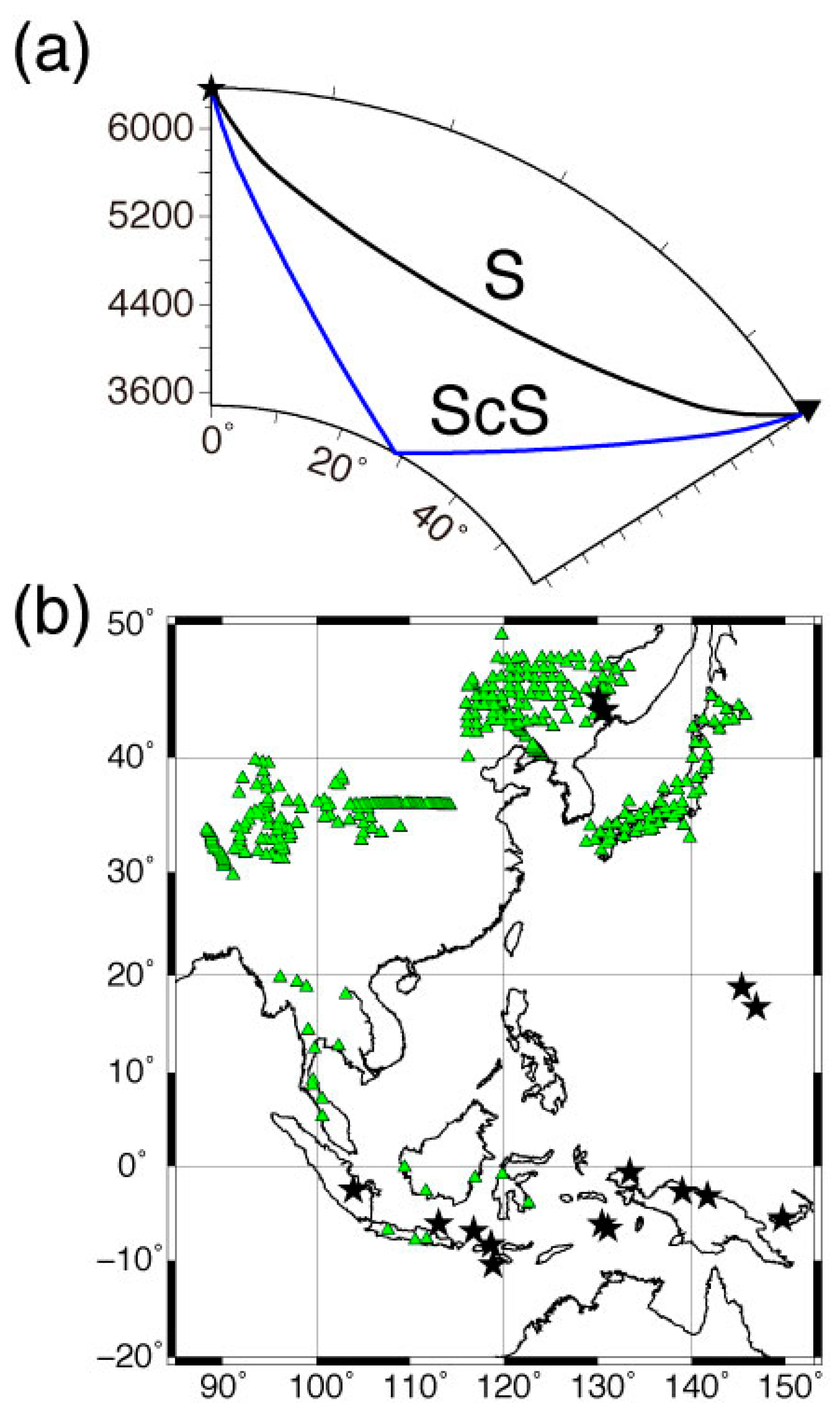

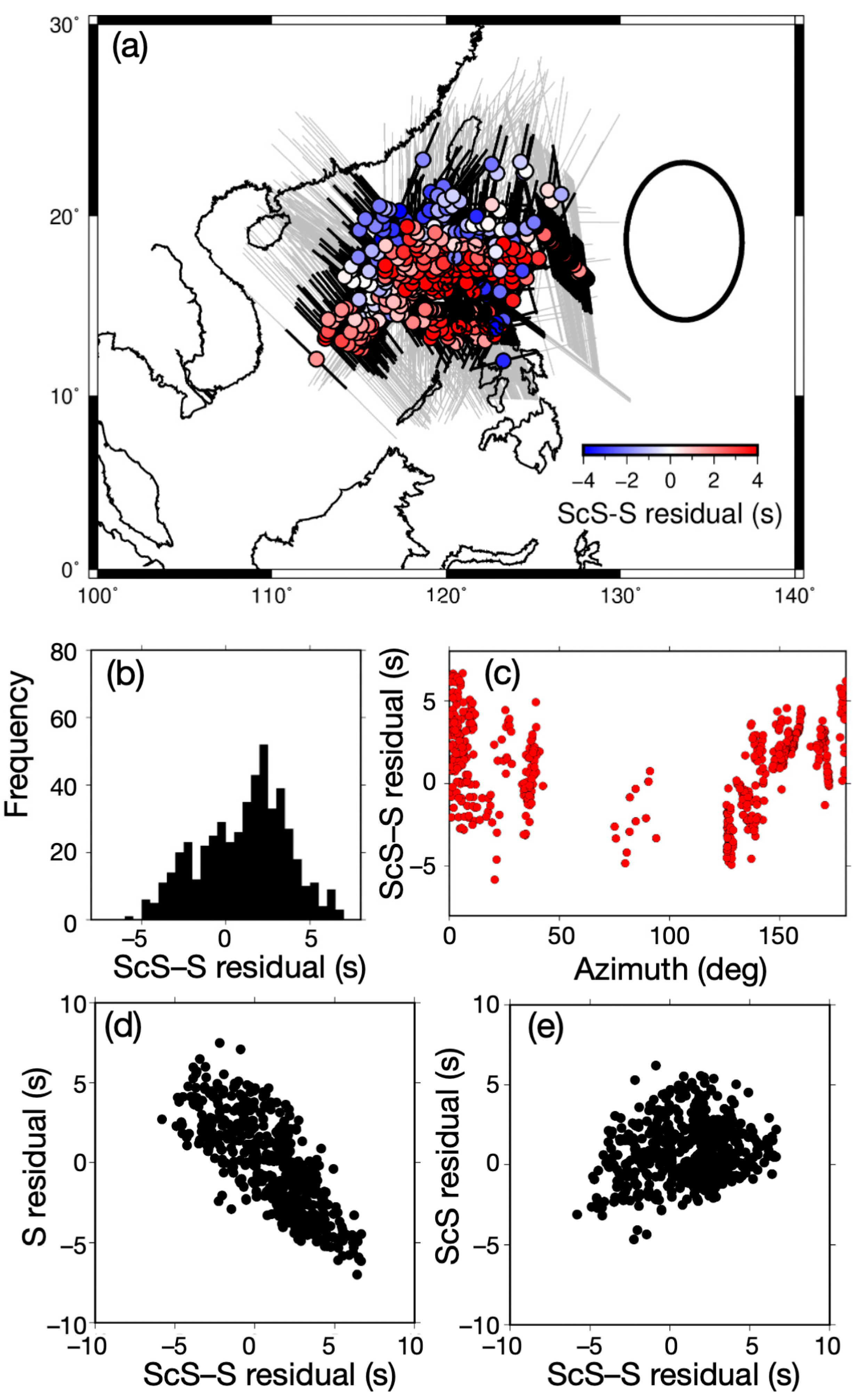
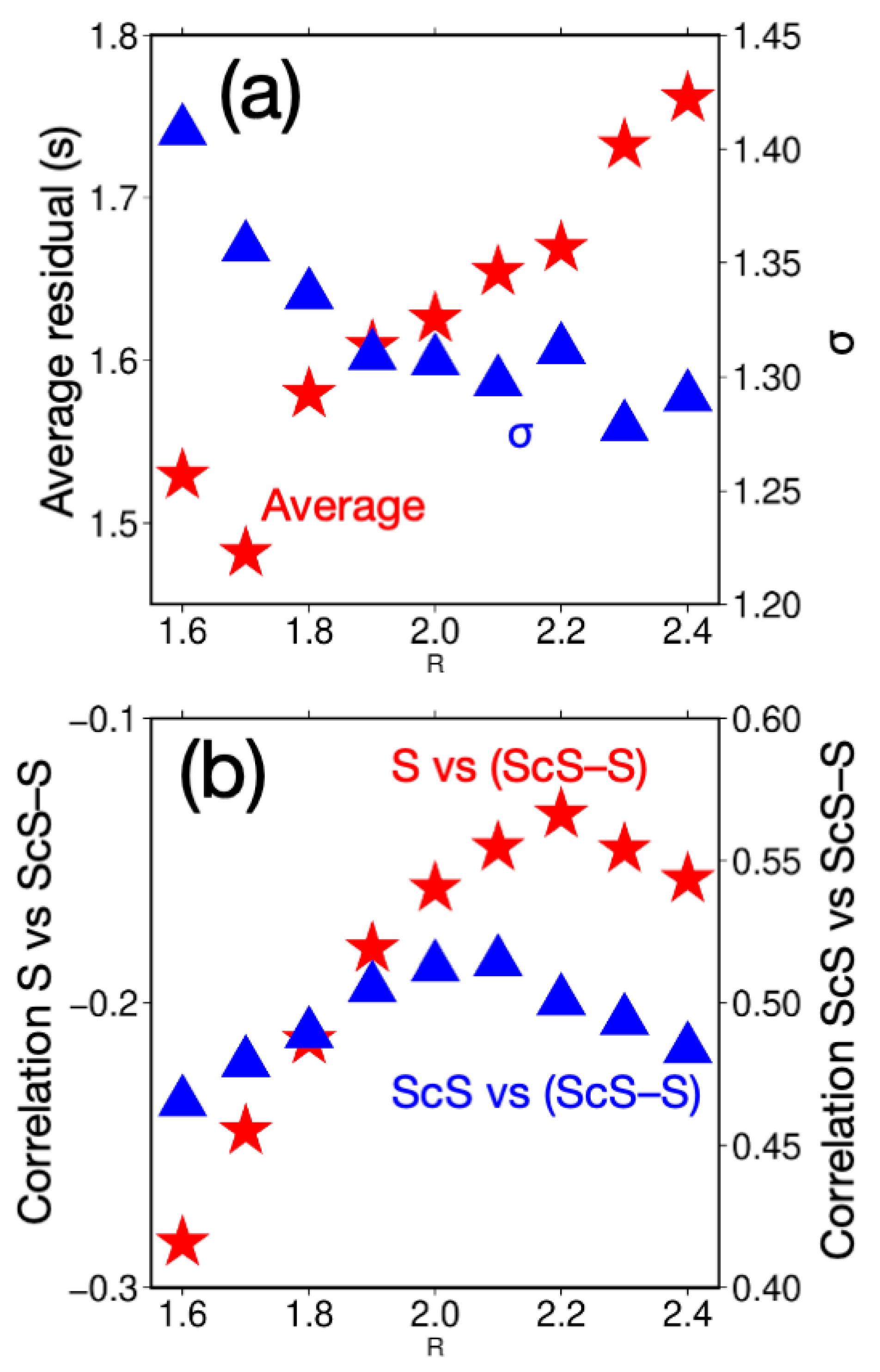
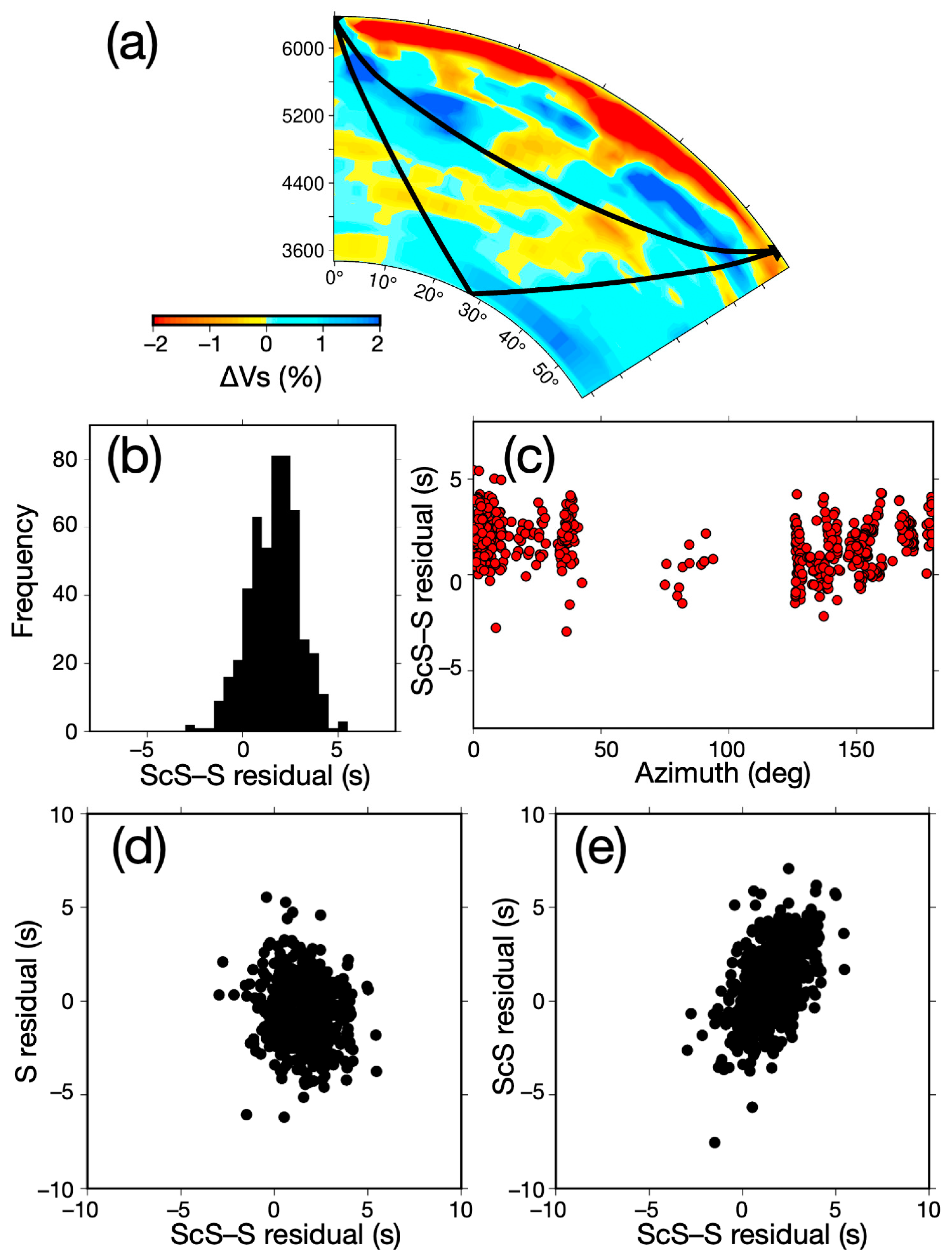
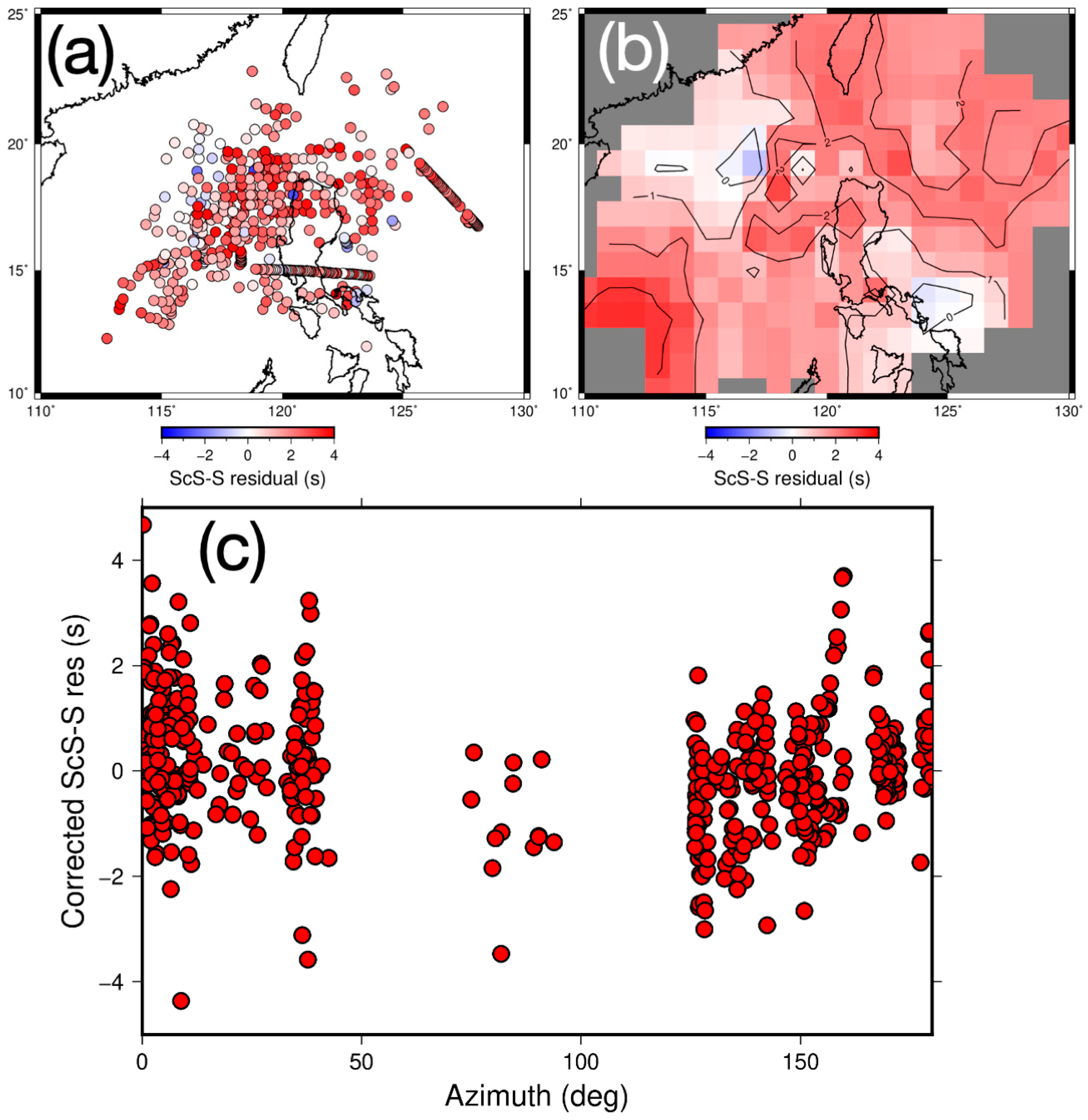


| No. | Date | Time (hour:min:sec) | Lat | Lon | Depth (km) | mb | Source | Network Code |
|---|---|---|---|---|---|---|---|---|
| 1 | 17 July 1998 | 08:49:23.40 | −3.2004 | 141.6695 | 34.3 | 5.5 | i | XR, IC |
| 2 | 29 July 1998 | 18:00:31.72 | −2.6960 | 138.9920 | 33.0 | 5.8 | e | XR, IC |
| 3 | 5 April 1999 | 11:08:04.23 | −5.6120 | 149.6660 | 138.0 | 6.1 | e | XR, IC |
| 4 | 8 April 1999 | 13:10:34.13 | 43.6090 | 130.4130 | 564.1 | 6.4 | i | JI, PS, GE |
| 5 | 28 June 2002 | 17:19:31.56 | 43.7690 | 130.6830 | 572.5 | 6.6 | e | JI, GE, II |
| 6 | 15 September 2002 | 08:39:32.72 | 44.6950 | 130.0670 | 586.3 | 5.8 | e | JI |
| 7 | 6 June 2004 | 09:38:07.07 | −6.1300 | 113.0260 | 581.2 | 5.6 | e | BO |
| 8 | 25 July 2004 | 14:35:18.56 | −2.5320 | 103.9320 | 582.2 | 6.8 | e | BO |
| 9 | 15 December 2007 | 09:39:55.46 | −6.6750 | 131.0680 | 76.7 | 6.0 | e | XG, XO, X4, Z8, 1A |
| 10 | 3 January 2009 | 22:33:39.55 | −0.6610 | 133.4010 | 18.2 | 6.5 | e | 8B, X4 |
| 11 | 24 October 2009 | 14:40:44.86 | −6.1820 | 130.4280 | 140.7 | 6.7 | e | CB, IC, ZV |
| 12 | 8 November 2009 | 19:41:43.70 | −8.3430 | 118.6180 | 21.3 | 6.2 | e | YP |
| 13 | 28 November 2009 | 06:04:24.83 | −10.4750 | 118.8170 | 33.2 | 5.8 | e | YP |
| 14 | 10 March 2011 | 17:08:37.08 | −6.9170 | 116.7530 | 517.4 | 6.2 | e | YP |
| 15 | 14 May 2013 | 00:32:25.80 | 18.7920 | 145.3320 | 603.8 | 6.2 | e | TM, IU |
| 16 | 28 August 2018 | 22:35:13.73 | 16.7605 | 146.8723 | 59.9 | 6.4 | e | TM, IU |
| Model for Correction | Average (s) | Standard Deviation (s) | Correlation Coefficient of ΔTScS–S vs. ΔTS | vs. ΔTScS |
|---|---|---|---|---|
| None | 1.07 | 2.58 | −0.77 | 0.20 |
| Mod. GAP-P4 (R = 2.1) | 1.65 | 1.30 | −0.15 | 0.51 |
| Parameters | Average | Standard Deviation |
|---|---|---|
| a | 0.81 | 0.10 |
| ϕ | −15.00 | 6.22 |
| E | −0.30 | 0.08 |
| ε | 1.09 | 0.04 |
Disclaimer/Publisher’s Note: The statements, opinions and data contained in all publications are solely those of the individual author(s) and contributor(s) and not of MDPI and/or the editor(s). MDPI and/or the editor(s) disclaim responsibility for any injury to people or property resulting from any ideas, methods, instructions or products referred to in the content. |
© 2025 by the author. Licensee MDPI, Basel, Switzerland. This article is an open access article distributed under the terms and conditions of the Creative Commons Attribution (CC BY) license (https://creativecommons.org/licenses/by/4.0/).
Share and Cite
Tanaka, S. The Use of Azimuthal Variation in ScS–S Differential Travel Times to Investigate Possible Anisotropy in the Lowermost Mantle Beneath the Philippines. Geosciences 2025, 15, 64. https://doi.org/10.3390/geosciences15020064
Tanaka S. The Use of Azimuthal Variation in ScS–S Differential Travel Times to Investigate Possible Anisotropy in the Lowermost Mantle Beneath the Philippines. Geosciences. 2025; 15(2):64. https://doi.org/10.3390/geosciences15020064
Chicago/Turabian StyleTanaka, Satoru. 2025. "The Use of Azimuthal Variation in ScS–S Differential Travel Times to Investigate Possible Anisotropy in the Lowermost Mantle Beneath the Philippines" Geosciences 15, no. 2: 64. https://doi.org/10.3390/geosciences15020064
APA StyleTanaka, S. (2025). The Use of Azimuthal Variation in ScS–S Differential Travel Times to Investigate Possible Anisotropy in the Lowermost Mantle Beneath the Philippines. Geosciences, 15(2), 64. https://doi.org/10.3390/geosciences15020064







